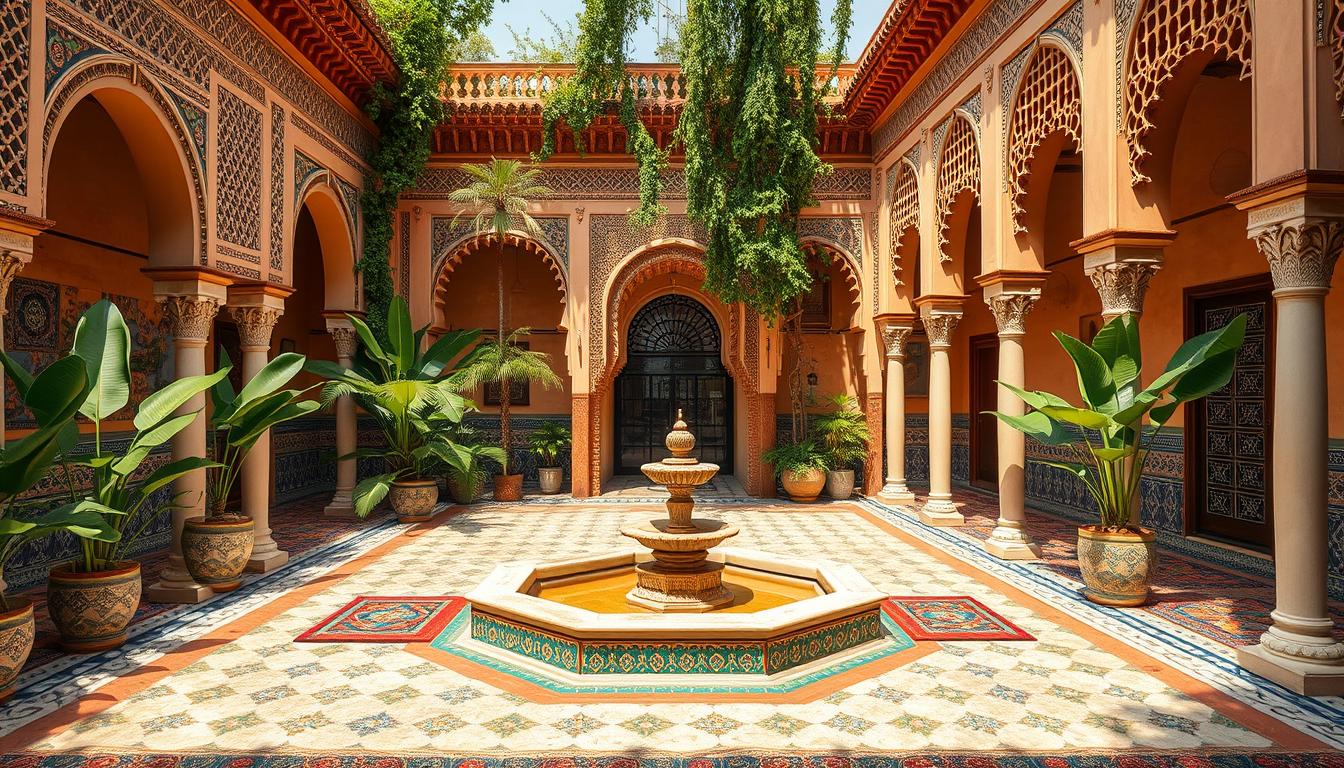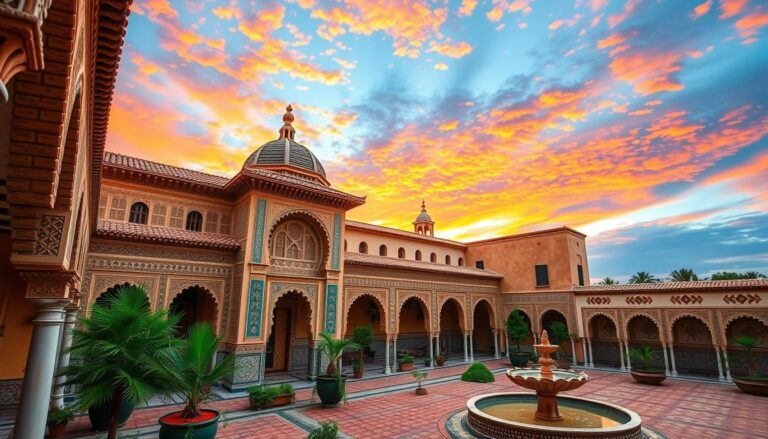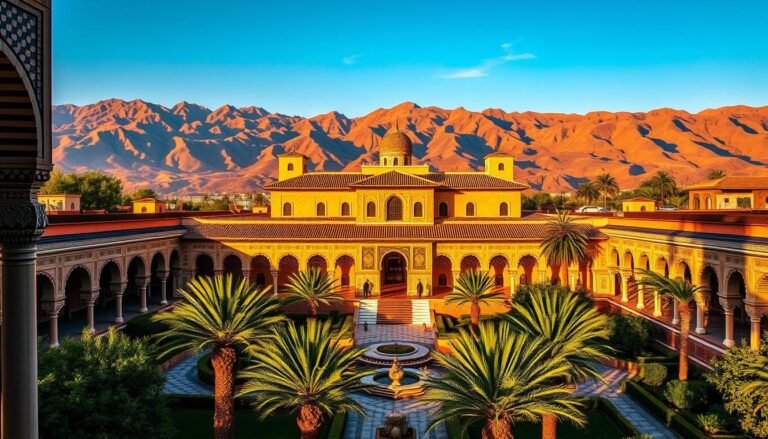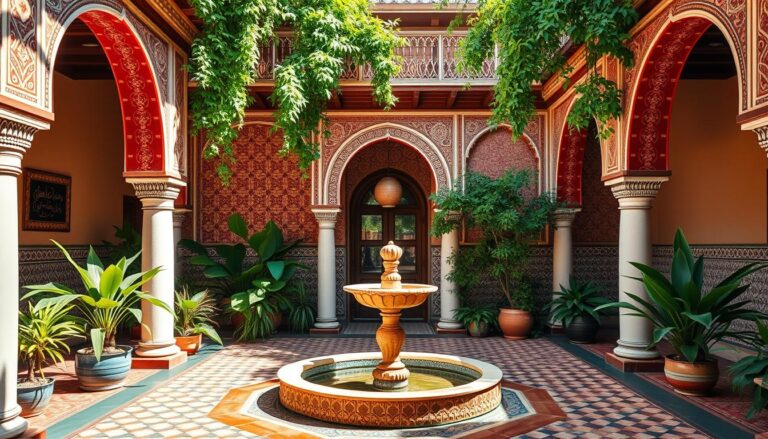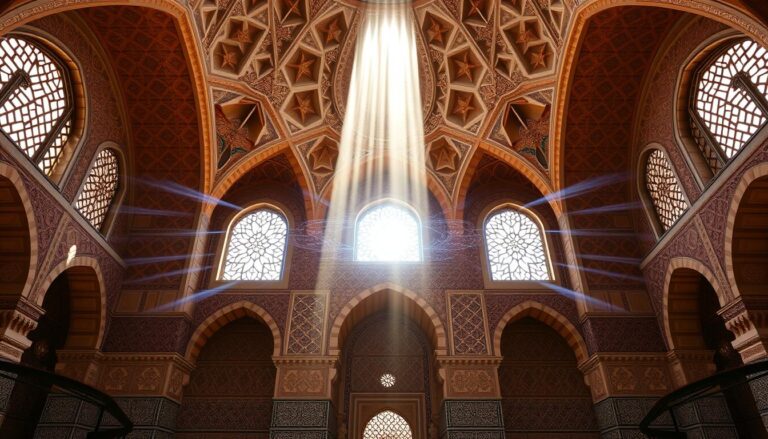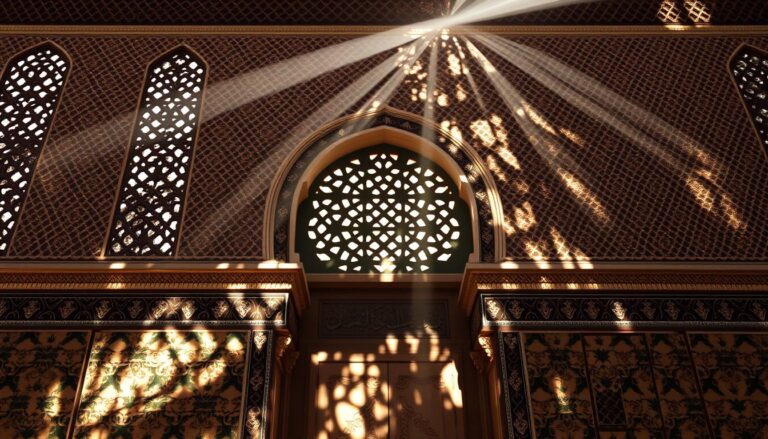Morocco’s architecture spans centuries, showing off its varied landscapes and deep culture. From ancient Roman ruins to stunning Islamic buildings, Moroccan design tells a story of many influences. But what do these structures really mean? How do they show what Morocco is all about?
Key Takeaways
- Moroccan architecture reflects a unique blend of indigenous styles and external influences, creating a distinctive identity.
- Zellige, or mosaic tilework, is one of the most iconic forms of Moroccan art, showcasing intricate geometric patterns and traditional colors.
- Minarets, tall towers used in the Islamic call to prayer, act as architectural centerpieces reflecting traditional Moroccan design.
- Moroccan craftsmanship is passed down through generations, with artisans preserving age-old traditions and techniques.
- The architectural marvels of Morocco, such as the Bahia Palace and the Koutoubia Mosque, showcase the country’s illustrious past.
Introduction to Moroccan Architecture
Moroccan architecture is a mix of local and outside influences. It shows the country’s deep cultural roots. From the ancient Amazigh (Berber) settlements in the Atlas Mountains to the famous Moorish buildings in cities, it’s a story of strength, change, and blending different traditions.
Blending Indigenous Influences and External Currents
Morocco’s traditional architecture started in the 7th century with Islam. It mixed Amazigh culture, pre-Islamic Spanish styles, and Islamic Middle East art. This created a unique Moorish or western Islamic style.
Iconic Monuments and Vibrant Styles
Morocco’s architecture is known for its unique styles and famous buildings. From the tall minarets and fancy gateways of old times to the beautiful gardens and strong palaces, each era has left its mark. Today, French colonial and Art Deco styles also mix with traditional Moroccan designs.
“Moroccan architecture is a tapestry of cultural influences, woven together over centuries to create a unique and captivating visual language.”
Symbolic Motifs and Patterns
Morocco’s architecture is a vibrant mix of colors, intricate patterns, and detailed designs. These elements show the country’s rich cultural background. At its core is the use of geometry and arabesque, a blend of shapes that amazes us.
The Language of Geometry and Arabesque
Geometric patterns are key in Moroccan art. They use symmetrical shapes and repeating motifs for harmony and balance. These designs flow beautifully, with plants falling down walls, creating a stunning visual experience.
Moroccan carpets, like the famous “Berber carpets,” display these detailed geometric designs and bright colors. They show the talent of the local artisans.
Zellige: The Art of Mosaic Tilework
Zellige, or mosaic tilework, is a standout in Moroccan architecture. It’s a traditional method where small, colorful tiles are cut and arranged to form intricate patterns. These patterns decorate mosques, palaces, and public areas.
The mix of colors and shapes in zellige shows the skill of Moroccan craftsmen. They have perfected this art over centuries, keeping the country’s artistic traditions alive.
“The geometric patterns in Moroccan architecture are not just visually stunning; they carry deep symbolic meaning, reflecting the country’s cultural identity and spiritual beliefs.”
From Berber rugs to zellige tilework, Moroccan architecture combines geometry and arabesque beautifully. It creates a stunning visual experience that connects to the nation’s cultural history.
Moroccan Architectural Symbolism
Architectural Semiotics and Cultural Representation
Moroccan architecture is more than buildings; it shows the country’s culture, beliefs, and society. The symbols, patterns, and famous landmarks in Morocco tell stories. They are like a language that shows the nation’s identity and traditions.
The architecture in Morocco mixes many styles. You can see Berber clay kasbahs, Islamic minarets, Moorish white walls, and French Art Deco. This mix creates a rich symbolism that connects to the country’s culture and faith.
Places like the Hassan II Mosque in Casablanca and the Ben Youssef Madrasa in Marrakech are more than sights. They symbolize Morocco’s culture and faith. The designs and tiles in these buildings tell stories of spirituality and tradition.
“Moroccan architecture is a canvas for the expression of the nation’s identity, traditions, and connection to the divine.”
Learning about Moroccan architecture’s symbols helps us understand the country’s culture and history. The buildings are a window into Morocco’s heritage. They invite us to discover the meanings and stories behind Moroccan architecture.
Islamic Architecture and Spiritual Symbolism
When Islam came to Morocco, it changed the way buildings were made. Mosques, fountains, and special patterns showed the faith’s importance. These designs were full of spiritual meaning.
Look at the minarets that call people to prayer. Or the calm courtyards and detailed zellige tiles. These parts of Islamic architecture in Morocco mean a lot. They connect us to something greater.
The green dome is special because of the Prophet Muhammad. Mosques like Al Masjid Al Nabawi in Saudi Arabia have them. The blue-tiled interiors of places like the Sultan Ahmed Mosque in Turkey bring peace.
Colors and patterns in Islamic architecture mean a lot. Green is for nature and paradise. Blue and gold show the divine. Numbers like 5 and 8 have special meanings too.
“Islamic architecture incorporates symbolic elements reflecting religious beliefs and cultural values, creating spaces for spiritual contemplation and community gathering.”
Arabesque designs and calligraphy with Quranic verses show the mix of faith, culture, and art. These buildings are more than just places to pray. They connect us to the divine and to each other.
Moorish Influences and Allegorical Design
Moroccan architecture is deeply rooted in the Moorish (or western Islamic) architectural tradition. This tradition dominated the Maghreb region and the former Muslim-ruled territories of al-Andalus, or Andalusia. The Almoravid and Almohad empires, which ruled over Morocco and parts of southern Spain, shaped Moroccan architecture.
The Legacy of Al-Andalus
The influence of Andalusian architecture is clear in Moroccan buildings. You can see garden design principles and Moorish architectural elements. Features like horseshoe and cusped arches, tilework, fountains, and ornate gateways and minarets show al-Andalus’ mark.
“The Alhambra palace complex is one of the most famous monuments of Islamic architecture, and was designated as a UNESCO World Heritage Site in 1984.”
The Alhambra is a stunning example of Moorish architecture. It shows the cultural exchange and architectural cross-pollination between Morocco and Spain. The intricate tilework, carved stucco, and geometric patterns in the Alhambra’s courtyards and palaces are symbols of Moroccan allegorical design.
The Moorish and Andalusian architectural influences have left a lasting legacy in Moroccan architecture. This rich tapestry continues to captivate and inspire people worldwide.
Metaphorical Architecture and Iconic Structures
Moroccan architecture is more than just buildings. It’s a way to express deep meanings and stories. The Hassan II Mosque in Casablanca is a prime example. It’s not just a beautiful building but also a symbol of Moroccan culture.
The Hassan II Mosque: A Modern Marvel
The Hassan II Mosque was finished in 1993. It shows off Morocco’s rich history and spiritual side. This modern wonder combines old Moroccan styles with new engineering. It’s a place where art and faith meet.
The mosque’s zellige tilework and tall minaret are more than just decorations. They show Morocco’s long history of art and its spiritual connection.
“The Hassan II Mosque is not just a place of worship, but a physical representation of Morocco’s cultural and spiritual essence.”
The mosque’s design is full of symbols. Its tall minaret and use of water are not just for looks. They represent Morocco’s Islamic heritage and its bond with nature.
The Hassan II Mosque is a true marvel. It mixes old Moroccan styles with new ideas. This iconic building shows Morocco’s deep understanding of architecture as a way to tell stories and share values.
Vernacular Architecture and Regional Diversity
Under Morocco’s famous landmarks lies a world of traditional architecture. This world is shaped by the country’s many regions. Moroccan architecture is known for its Islamic and Moorish styles. But, the Amazigh (Berber) regions, like the Atlas Mountains and Sahara, also have their mark.
The kasbahs (fortresses) and ksour (fortified villages) in these areas show Moroccan Amazigh architecture’s genius. Made from rammed earth and decorated with geometric patterns, they fit perfectly into their surroundings. This shows a deep connection to the land and local ways of life.
“Moroccan vernacular architecture is a living testament to the country’s Amazigh heritage, a fusion of indigenous influences and external currents that have forged a truly unique architectural identity.”
These Amazigh structures have been shaped by Islamic and Moorish designs. Yet, they also add to Morocco’s diverse and unique architectural scene. From the High Atlas kasbahs to Sahara ksour, this architecture tells the story of Morocco’s cultural richness.
As Morocco grows, keeping these traditional architectural styles alive is key. It helps preserve the country’s cultural identity and honors its Amazigh heritage.
Conclusion
Moroccan architecture is a mix of many styles, from Berber to Islamic and colonial. It shows the country’s cultural heritage, spiritual beliefs, and social life. The use of symbolic motifs, geometric patterns, and famous buildings tells the story of Morocco.
These designs, made with geometry, arabesque, and zellige tiles, show the skill of Moroccan artists. They are a lasting sign of the country’s creativity.
As Morocco grows, its buildings keep showing its unique identity. They mix old and new styles, keeping the cultural legacy alive. This architectural diversity shows Morocco’s talent in combining traditions.
Moroccan architecture is loved around the world for its beauty and meaning. It uses symbols, patterns, and landmarks to express itself. Efforts to save this heritage will keep inspiring people for years.
Source Links
- The Rich and Vibrant History of Moroccan Architecture.
- Exploring the rich art, architecture, and craftmanship of Morocco – SA Expeditions
- Moroccan architecture
- Moroccan Architecture: In-Depth Review of Styles in Morocco
- The Symbolism of Moroccan Patterns: Unraveling the Meanings
- Symbolic Meanings in Moroccan Berber Rugs: Exploring Geometric Shapes
- Exploring the Richness of Moroccan Architecture – Cindrebay
- The Legacy of Brutalism on Morocco’s Post-independence Architectural Landscape
- Online IAP Lecture: Building the Independent Nation. Morocco’s architectural heritage, 1940-1980 | Aga Khan Documentation Center
- The Symbolic Use of Color in Islamic Architecture
- Islamic art and symbolism | Symbolism in Art Class Notes | Fiveable
- Alhambra
- Cultural Heritage of Zellij in Moroccan Architecture | Paris Tile
- Moorish Architecture in Andalusian Cities: A Deep Dive
- Modern Morocco: Building a New Vernacular
- Desert Blooms: The Contemporary Architecture of Morocco – Architizer Journal
- Exploring the Timeless Beauty of Moroccan Architecture | African Sahara
- A Journey Through Andalusian Influence and Artistic Mastery – Art Maze

The Editorial Team is a passionate group of Morocco enthusiasts dedicated to sharing the beauty, culture, and wonders of this captivating country. With diverse backgrounds and a deep love for travel, we strive to bring you engaging and informative content that inspires your Moroccan adventures. From uncovering hidden gems and sharing local insights to exploring mouthwatering cuisine and showcasing the vibrant lifestyle, our team is committed to providing you with valuable resources and exciting stories that enhance your exploration of Morocco. Join us on this journey as we celebrate the rich heritage and unforgettable experiences that make Morocco truly special.

